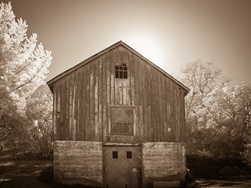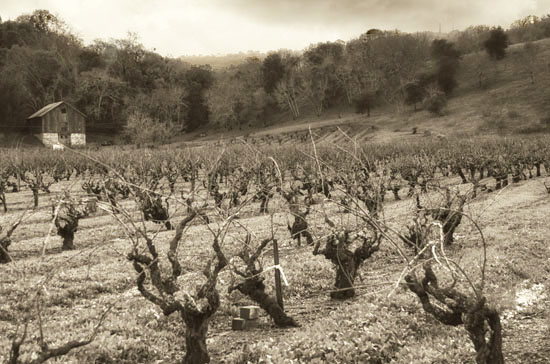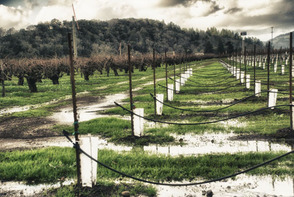Pagani Ranch - Sonoma Valley
Photography: Adriana Arriaga (infrared), Peter Griffith, and Cathleen Francisco
|
Felice built this two-story barn prior to the 1906 earthquake. After the quake only one wall needed repairs, but otherwise the barn held strong and is still used for equipment storage.
|
When Felice Pagani left his home in northern Italy he was a young man with an uncertain future, but like many emigrants he was drawn to America by the hope of work and the opportunity to prosper. After a few years of working on the East coast, he headed west finding work in the vineyards in Sonoma. The year was 1885. The first ranch Felice worked for, and eventually became overseer, was the Goldstein Ranch, a vineyard in Sonoma (now named Monte Rosso). Nestled in the Mayacamas Mountain, at an elevation of 1200 feet, the Goldstein Ranch was one of several field blended zinfandel vineyards being established in the area, including the now historic Old Hill and Bedrock Vineyards. |
Winegrapes were first planted in Sonoma County as early as 1812, and by the mid 1850s the vineyards were shaping the landscape along side orchards of apples, fields of berries, groves of nuts and olives. Luther Burbank, who established his experimental nurseries in the area during this time, said of Sonoma that is was “the chosen spot of all this earth as far as Nature is concerned.” Agriculture of all kinds was on the rise but sadly, for the vineyards, the devastation of phylloxera was looming.
The root louse phylloxera is microscopic, but the magnitude of its destruction in the mid to late 1800s threatened the survival of the vineyards and the wine industry. Ultimately phylloxera redefined how Vitis vinifera was to be grown, not just in California, but in many regions around the world. While various methods were attempted to rid the vineyards of the pest the most practical remedy in managing the insect was, and still is, to graft Vitis vinifera to native American rootstock such as Vitis rupestris, commonly referred to as St. George, which is resistant to the bug.
The root louse phylloxera is microscopic, but the magnitude of its destruction in the mid to late 1800s threatened the survival of the vineyards and the wine industry. Ultimately phylloxera redefined how Vitis vinifera was to be grown, not just in California, but in many regions around the world. While various methods were attempted to rid the vineyards of the pest the most practical remedy in managing the insect was, and still is, to graft Vitis vinifera to native American rootstock such as Vitis rupestris, commonly referred to as St. George, which is resistant to the bug.
|
With a way to manage the blight, replanting began in earnest. Felice and his crew helped replant the Goldstein ranch and found extra work in other vineyards in the valley whose vines where showing signs of decline. He nurtured the fledgling vines and replanted the ones that were succumbing to the louse. Over a hundred years have passed since then, and yet many of the vines Felice helped to plant still live on, producing fruit highly valued by winemakers.
|
A few miles down the road from Goldstein's was a small, valley vineyard owned by Judge Cook, a San Francisco magistrate with extensive property holdings in the area. He lived in the city but enjoyed being a part of the Sonoma community, often coming up to spend time with his friend Jack London, who was buying property nearby for his Beauty Ranch. The vineyard was about 25 acres, field blended and a vineyard that Pagani had worked in from time to time. When Cook put the property up for sale in 1903, Felice bought it. Several years later Felice acquired an adjoining parcel to plant more vines and the ranch grew to 55 acres.
While working at Goldstein’s Felice married Angela Bogani, a young woman he knew from his village in Italy and who had come to California at his request. Now with children of their own, Felice moved his growing family from the Goldstein Ranch to their own farm. Young, ambitious and determined, Angela and Felice settled into a life of hard work and the rich reward of a life lived on the land they would come to love and cherish.
The Pagani Ranch remains in the family, the vineyards their passion and way of life. Angela and Felice’s granddaughter Norma is now the matriarch, living and working the ranch since 1972. Her son, Dino is the vineyard manager, tending to vines his great grandfather planted - the beauty of that blessing is not lost on Dino.
While working at Goldstein’s Felice married Angela Bogani, a young woman he knew from his village in Italy and who had come to California at his request. Now with children of their own, Felice moved his growing family from the Goldstein Ranch to their own farm. Young, ambitious and determined, Angela and Felice settled into a life of hard work and the rich reward of a life lived on the land they would come to love and cherish.
The Pagani Ranch remains in the family, the vineyards their passion and way of life. Angela and Felice’s granddaughter Norma is now the matriarch, living and working the ranch since 1972. Her son, Dino is the vineyard manager, tending to vines his great grandfather planted - the beauty of that blessing is not lost on Dino.
|
Grape Varieties: Zinfandel, Sauvignon Vert, Matero, Palomino, Grand Noir, Carignane, Alicante, Petite Sirah, Lenoir
Soil Types: Gravely Loam and Gravely Clay Loam. Tuscan Red Clones used for new plantings: Zinfandel Dupratt, Zinfandel Primitivio and Zinfandel Nova. |
|
The old vines seem as if they could go on for another 100 years, and so they may. But they won't live forever and an old vine produces less as it ages, so the family decided it was time to expand the vineyard. Dino chose an uncultivated portion of the farm and planted some young vines there - mixed blacks and zinfandel - head trained, like the old vines. Throughout the old blocks there are interplanting of young vines, but the new vineyard was a major undertaking, with twelve and half acres planted and a new well for irrigation dug. Dino has hopes to one day expand the vineyard even more.
|
|
Owner: Pagani Family
Vineyard Manager: Dino Pagani Amantite, Director of Vineyard Operations and Grape Sales for Cook Vineyard Management |
Pagani Ranch is home to the Pagani family. This is private property with no public access.
|




